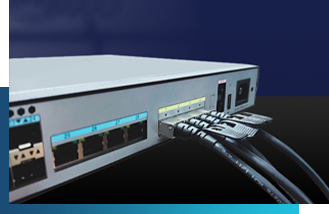
10 Gigabit Small Form-factor Pluggable (SFP) transceivers, commonly known as 10G SFPs, are compact modules used for data transmission over fiber optic cables in various networking applications. This guide dives into the world of 10G SFPs, covering their types, features, applications, and selection factors.
10GBASE-SX: For short-range connections using multimode fiber, up to 550m. Typically the most cost-effective option for intra-datacenter links.
10GBASE-LX: Designed for longer reach on single-mode fiber, up to 10km. Suitable for data center interconnect (DCI) and enterprise network backbones.
10GBASE-EX: Offers extended reach over single-mode fiber, up to 40km. Ideal for long-distance DCI deployments.
10GBASE-T: Enables 10GbE transmission over copper twisted-pair cabling, up to 100m. Convenient for connecting switches and servers within short distances.
10GBASE-CWDM: Employs coarse wavelength division multiplexing (CWDM) to transmit four 2.5Gb/s signals on different wavelengths over a single fiber, maximizing fiber utilization.
10GBASE-BiDi: Utilizes a single fiber for both transmitting and receiving data, saving fiber count and potentially reducing costs.
Data Rate: Ensure the transceiver supports the desired speed, typically 10 Gigabit Ethernet (10GbE).
Wavelength: Match the wavelength to your fiber infrastructure (e.g., 850nm for SX, 1310nm for LX/EX).
Transmission Distance: Choose based on your link length requirements (short, medium, or long range).
Fiber Type: Select multimode or single-mode compatible with your network.
Power Consumption: Consider power draw, especially in high-density environments.
Management Features: Some offer Digital Optical Monitoring (DOM) for performance insights.
Vendor Reputation and Warranty: Opt for reliable brands with suitable warranties.
10G SFP transceiver, despite their maturing technology, still hold significant value in numerous networking applications across various industries. Here's a breakdown of their key applications:
Intra-rack and inter-rack connections: 10GBASE-SX transceivers are cost-effective for short-range links within racks or across adjacent racks, connecting switches, servers, and storage devices.
Data center interconnect (DCI): 10GBASE-LX and EX transceivers bridge data centers over longer distances using single-mode fiber, enabling data replication, disaster recovery, and communication between geographically dispersed facilities.
High-performance computing (HPC): Interconnecting HPC clusters for parallel processing tasks demands high bandwidth. 10G SFPs can provide sufficient speed for specific requirements, though faster options might be emerging for cutting-edge HPC needs.
Building cloud infrastructure: 10G SFPs are suitable for building the internal network fabric within cloud data centers, connecting servers, storage, and network equipment.
Connecting cloud data centers: 10GBASE-LX and EX transceivers can be used for DCI between geographically distributed cloud data centers, supporting data replication and workload distribution.
Network backbone upgrades: Upgrading enterprise network backbones to handle increasing traffic from applications like video conferencing, collaboration tools, and large file transfers. 10G SFPs offer a balance between cost and performance for backbone upgrades.
Campus network connections: Connecting buildings and campuses within an organization's network with high-speed links, improving collaboration and data sharing across offices. 10GBASE-T transceivers can be used for shorter copper connections within buildings.
Metro and access network upgrades: Modernizing metro and access networks to handle growing mobile backhaul and broadband internet access demands. 10G SFPs can be used for specific links within the network, while newer technologies might be employed for core infrastructure.
Research and education networks: Enabling high-speed data transfer for scientific collaborations and data analysis in research institutions.
Financial institutions: Supporting transaction processing needs with reliable data connectivity.
Healthcare networks: Enabling data access for medical imaging and patient records.
Manufacturing and automation: Supporting real-time data communication and control in industrial applications.
Data Rate: Ensure the transceiver supports 10 Gigabit Ethernet (10GbE).
Wavelength: Match the wavelength to your fiber infrastructure (850nm for SX, 1310nm for LX/EX).
Transmission Distance: Choose based on your link length requirements (short, medium, or long range). Options include:
SX: Up to 550m on multimode fiber (intra-datacenter links).
LX: Up to 10km on single-mode fiber (DCI, enterprise backbones).
EX: Up to 40km on single-mode fiber (long-distance DCI).
T: Up to 100m on copper twisted-pair cabling (short-range connections).
Fiber Type: Select multimode or single-mode compatible with your network.
Power Consumption: Consider power draw, especially in high-density environments.
Management Features: Some offer Digital Optical Monitoring (DOM) for performance insights.
Cost: Balance functionality with budget constraints.
Vendor Reputation and Warranty: Opt for reliable brands with suitable warranties.
Specific Application Needs: Tailor your choice based on specific use cases like DCI, cloud, HPC, or other network requirements.
Future Needs: Consider if 10G SFPs meet your long-term bandwidth requirements. Faster options like 25G or 40G SFP+ might be necessary for future upgrades.
What is the distance you need to cover?
Short (intra-rack): SX
Medium (DCI): LX
Long (long-distance DCI): EX
Short copper connection: T
What type of fiber are you using?
Multimode: SX
Single-mode: LX, EX
What are your budget constraints?
SX is typically the most cost-effective.
Do you need advanced features like DOM?
Choose transceivers with DOM if performance monitoring is crucial.
Consider future needs and potential upgrades.
There's no one-size-fits-all solution. By carefully evaluating your network needs and technical specifications, you can choose the optimal 10G SFP transceiver to optimize performance, efficiency, and cost within your network.
